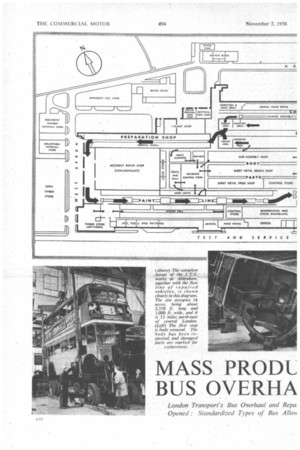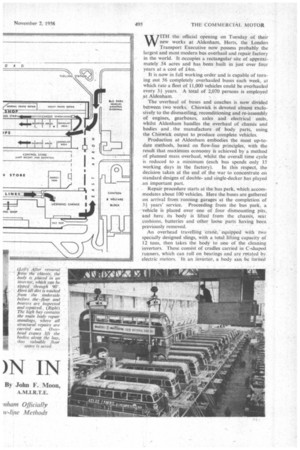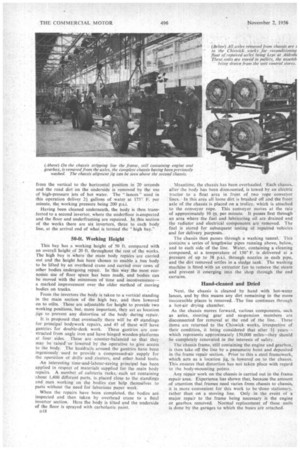MASS PRODL BUS OVERHA
Page 56

Page 57

Page 58

Page 59

If you've noticed an error in this article please click here to report it so we can fix it.
By John F. Moon,
A.M.I.R.T.E. WLTH the official opening on Tuesday of their new works at Aldenham, Herts, the London Transport Executive now possess probably the largest and most modern bus overhaul and repair factory in the world. It occupies a rectangular site of approximately 54 acres and has been built in just over four years at a cost of £4m.
ft is now in full working order and is capable of turning out 56 completely overhauled buses each week, at which rate a fleet of 11,000 vehicles could be overhauled every 31 years. A total of 2,070 persons is employed at Aldenham.
The .overhaul of buses and coaches is now divided between two works. Chiswick is devoted almost exclusively to the dismantling, reconditioning and re-assembly of engines, gearboxes, axles and electrical units, whilst Aldenham handles the overhaul of chassis and bodies and, the manufacture of body parts, using the Chiswick output to produce complete vehicles.
Production at Aldenham embodies the most up-todate methods, based on flow-line principles, with the result that maximum economy is achieved by a method of planned mass overhaul, whilst the overall time cycle is reduced to a minimum (each bus spends only 15 working days in the factory). In this respect, the decision taken at the end of the war to concentrate on standard designs of doubleand single-decker has played . an important part.
Repair procedure starts at the bus park, which accommodates about 100 vehicles. Here the buses are gathered on arrival from running garages at the completion of 31 years' service. Proceeding from the bus park, a . vehicle is placed over one of four dismounting pits, and here. its body is lifted from the chassis, seat cushions, batteries and other loose parts having been previously removed.
An overhead travelling crane,equipped with two specially designed slings, with a total lifting capacity of 12 tons, then takes the body to one of the cleaning invertors. These consist of cradles carried in C-shaped runners, which can roll on bearings and are rotated by
electric motors. an invertor, a body tan be turned
from the vertical to the horizontal position in 20 seconds and the road dirt on the underside is removed by the use of high-pressure jets of hot water. The " lances " used in this operation deliver 21 gallons of water at 175° F. per minute, the working pressure being 200 p.s.i.
Having been cleaned underneath, the body is then transferred to a second invertor. where the underfloor is.inspected and the floor and underframing are repaired. In this section of the works there are six invertors, three to each body line, at the arrival end of what is termed the "high bay."
50-ft. Working Height
This bay has a working height of 50 ft. compared with an overall height of 20 ft. throughout the rest of the works. The high bay is where the main body repairs are carried out and the height has been chosen to enable a bus body to be lifted by an overhead crane and carried over rows of other bodies undergoing repair. In this way the most economic use of floor space has been made, and bodies can be moved with the minimum of time and inconvenience— a marked improvement over the older method of moving bodies on trucks.
From the invertors the body is taken to a vertical standing in the main section of the high bay, and then lowered on to stilts. These are adjustable for height to provide two working positions, but, more important, they act as location jigs to prevent any distortion of the body during repair.
It is proposed that eventually there will be 49 standings for principal bodywork repairs, and 45 of these will have gantries for double-deck work. These gantries are constructed from angle iron and have hinged wooden-platforms at four sides. These are counter-balanced so that they may be raised' or lowered by the operative to give access La the body. The handrails around the gantries have been ingeniously used to provide a compressed-air supply for the operation of drills and riveters, and other hand tools.
An interesting time-and-labour-saving principal has been applied in respect of materials supplied for the main body repairs. A number of cafeteria racks, each set containing about 1,400 different parts, is placed close to the standings and men working on the bodies can help themselves to parts without the need for laborious paper work.
When the repairs have been completed, the bodies are inspected and then taken by overhead crane to a final invertor section. Here the body is tilted and the underside of the floor is sprayed with carbolastic paint.
D I 8 Meantime, the chassis has been overhauled. Each chassis. after the body has been dismounted, is towed by an electric tractor to a float area in front of two rope conveyor lines. In this area all loose dirt is brushed off and the front axle of the chassis is placed on a trolley, which is attached to the conveyor rope. This conveyor moves at the rate of approximately 10 in. per minute. It passes first through an area where the fuel and lubricating oil are drained and the radiator and electrical components are removed. The fuel is stored for subsequent testing of repaired vehicles and for delivery 'purposes.
The chassis then passes through a washing tunnel. This contains a series of lengthwise' pipes running above, below, and to each side of the line. Water, containing a cleaning compound, at a temperature of 150° F. is delivered at a pressure of up to 38 p.s.i. through nozzles in each pipe, and the dirt removed settles in a sludge tank. The washing machine is fitted with an extractor fan to remove the steam and prevent it emerging into the shop through the end curtains.
Hand-cleaned and Dried
Next, the chassis is cleaned by hand with hot-water lances, and by this means any dirt remaining in the more inaccessible places is removed. -The line continues through a hot-air drying chamber.
As the chassis moves forward, various components, such as axles, steering gear and suspension members are disconnected for removal at the end of the line. These items are returned to the Chiswick works, irrespective of their condition, it being considered that after 31 yearswhich represents approximately 150,000 miles—they should be completely renovated in the interests of safety.
The chassis frame, still containing the engine and gearbox, is then take off the line by a pneumatic hoist and deposited in the frame repair section. Prior to this a steel framework, which acts as a location jig, is lowered on to the chassis. This ensures that distortion has not taken place with regard to the body-mounting points.
Any repair work on the chassis is carried out in the frame repair area. Experience has shown that, because the amount of attention that frames need varies from chassis to chassis, it is more convenient for this work to be-done stationary, rather than on a moving line. Only in the event of a major repair to the frame being necessary is the engine or gearbox removed. Normal replacement of these units is done by the garages to which the buses arc attached.
After checking, the frame is passed to the chassis-asSembly conveyor. This has been made shallow by the use of a series of concrete slabs, 2i in. thick. 10 ft.-wide and 3 ft. long, which,are moved down a roller track. At the end of the line each slab is moved vertically downwards, is turned through 90° by hydraulic rams and passed into a channel' running between the roller tracks. The slabs, lying vertically, are returned at high speed to the starting point, where they are again turned through a right-angle and lifted on to the roller track.
On this line, reconditioned axles and suspension assemblies are fitted, and the chassis is reassembled. At the end, the assembled chassis is again checked for alignment and completely inspected.
After the inspection, the chassis passes into a spraying booth, the floor of which can be tilted to afford easy access' to the underside. Aluminium paint is employedand not only gives protection against corrosion, but makes it easier for fitters to see' the parts during subsequent repairs.
In the case of the Routemaster integral double-deckers the same repair procedure iS carried out, but the front and rear running assemblies arc passed up the line separately.
Any Body on Any Chassis
The chassis then moves into a float to 'await a body. Although both A.E.C. and Leyland vehicles arc used. the high degree of standardization employed thrqughout the fleet enables any body to be mounted on any chassis. The complete vehicle is towed to a refuelling point, after which a road test is carried out on the works estate. Should any faults become apparent, the bus is driven to a rectification shop.
Bodywork is then prepared for painting. The paint preparation area is divided into two sections, one for wet work and one for dry. Special light three-tier gantries are used in the wet standing, enabling each vehicle to be washed inside and out and flatted to secure a smooth surface for painting.
In the dry standing a primer coal of paint is brushed on to any part from which the stove-enamelled primer has been removed, and the final colour coat is given to the distinctive cream band which runs horizontally round the body at the level of the upper-deck floor. Any necessary painting is also done to the interior, paint rollers being used for the interior roofs.
Having been fully prepared for painting, the body is masked. The cream band is covered with adhesive paper, the rear entrance is protected by a quickly detachable closely fitting dooi, the windows are masked by quickly attached wooden covers, and A. Oste which can readily be scraped off after painting is applied to the driver's cab glazing and to destination-indicator glasses.
The bus is then towed to the painting line, which consists of a 680-ft.-long
twin-strip conveyor. This Moves forward 40 ft: once every hour. At the first movement the bus passes into the'ctilbur booth, where it receives two coats of colour, wet on wet.
For the next three -moves the vehicle remains in the open shop and during this time the paint dries at workshop temperature. Towards the end of this section, touching up is carried out and all transfers are affixed. . Next the bus passes to the first varnish booth and thereafter to a drying oven, which is long enough to contain three vehicles. It remains in the oven for three hours.
16 Buses on Paint Line
A second coat of varnish is applied another booth and the bus is again dried in an 'oven. It is thus possible to accommodate 16 buses on the line at any time.
When the Masking shields and paste have been removed. the bus is-towed on to a linishing-line conveyor, 'which Can dccommodate eight vehicles and also Moves approximately 40 ft. once an hour. Here the final exterior cleaning-up is done,and interior fittings are replaced.
From the finishieg line, the completed vehicle passes into the licensing garage. Here the vehicle is eamined by L.T.E. staff and Ministry of Transport certifying officers.
The fully overhauled bus is then delivered to its appointed garage. During its stay of about 15 working days at Aldenham, it will have required four or five days in the body-repair and chassis-overhaul sections.
The flow line of the principal operations follows a U-shaped path through the works. The area inside this U accommodates the accident-repair shop, stores, body-parts section (including a press shop) and other sub-assembly sections. The accident-repair shop is used for repairs which do not entail the removal of the bodywork.
In the section devoted to body parts, components and fittings removed during the body-overhaul stages are cleaned, checked and repaired or replaced, being then returned to the stores. Bonderizing and stove enamelling are applied to all metal parts, other than plated pieces.
To the south of the finishing lines there is a trimming shop Where all upholstered items are cleaned And repaired, whilst adjacent to this section destination blinds are manufactured. Several special machines are employed for this purpose and the blinds themselves are made up of sections of printed paper gummed to linen backing. These blinds may he up to 50 ft. long, carrying up 10 100 names.
















































































































